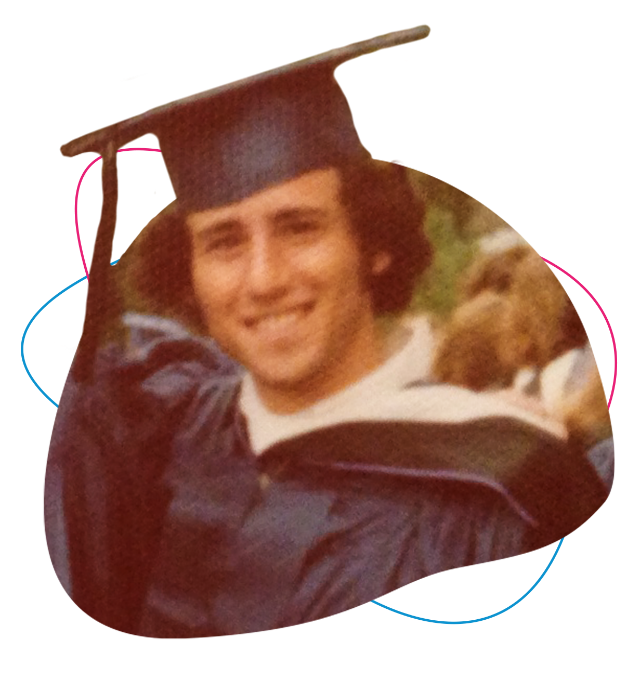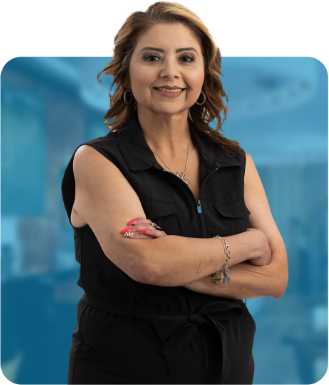WAYNE’S STORY
patient Story
“Like many people with type 1 Gaucher, I endured the fear and frustration of not knowing what was wrong with me year after year…”
Delayed diagnosis of a progressive disease
As a child, Wayne presented with common type 1 Gaucher symptoms, including frequent nosebleeds, fatigue, easy bruising, and splenomegaly. When Wayne was 10 years old, he experienced an episode of acute pain in his right thigh. His mother called his pediatrician and he was admitted to hospital. It was suggested that Wayne’s complaints were for attention, but his parents disregarded this. Leukemia was then suspected but was soon ruled out without any other possible explanations.
After weeks of intractable pain, Wayne’s condition inexplicably improved. The doctors concluded that he had an episode of osteomyelitis and then recovered. Four years later, Wayne had a similar episode, followed by another attack a year later. In high school, Wayne struggled to walk as he experienced a reduced range of motion in his hip. His parents called an orthopedic surgeon, who diagnosed avascular necrosis with partial collapse of the bone and hip.
Finally, when Wayne was 15 years old, his family physician, a hematologist, correctly identified his health issues as type 1 Gaucher disease after years of uncertainty.
patient profile
NAME: Wayne
AGE: 70s
AGE AT TYPE 1 GAUCHER DIAGNOSIS: 15
ETHNICITY: Ashkenazi Jewish
TREATMENT HISTORY: VPRIV, 15 years
SYMPTOMS AT BASELINE: Enlarged spleen, low hemoglobin, low platelets

“The pain in my side was from my massively enlarged spleen catching on my rib with each breath.”
Gaucher disease complications
Throughout high school, Wayne was using crutches to walk. He had surgery to repair his hip after graduation. Over the next few years, Wayne focused on studying to become a psychologist. At the start of his on-campus residency, he began to feel sick; his head hurt, he felt fatigued, and there was an acute pain on the left side of his abdomen. The campus physician, who knew about type 1 Gaucher disease, determined the cause to be his extremely enlarged spleen. Wayne also had thrombocytopenia and was bleeding internally, leading to an urgent splenectomy.
Years later, Wayne’s repaired hip became increasingly painful and required replacement surgery. Wayne recovered well from this surgery and was walking without pain, until he faced another setback.
At 39 years old, as a husband and father of two young boys, Wayne was diagnosed with an aggressive soft tissue cancer in his leg. He was determined to recover for his family and went through radiation and surgery. Both were unsuccessful and Wayne was presented with several surgical options, including the amputation of his leg. Wayne believed that this was his best chance to return to his family life and career.
“Within my lifetime, type one Gaucher has progressed from a frightening mystery to a manageable condition.”
Grateful for available type 1 Gaucher disease treatment
When Wayne’s type 1 Gaucher disease first presented, no treatment was available and information about the disease was very limited. All Wayne and his father were able to find was one brief definition in a medical textbook: type 1 Gaucher disease is metabolic, genetic, and chronic. Years later, at a National Gaucher Foundation meeting, Wayne was excited to learn about enzyme replacement therapy (ERT). He kept himself updated on the development of ERT over the years. In 1993, Wayne started enzyme replacement therapy in an infusion center. Despite initially thinking that his infusions would be disruptive, he now thinks of them as part of his routine and lifestyle.
“[I did] my best to avoid any treatment disruptions with VPRIV,
because I believe this treatment has really worked for me.”
Wayne’s VPRIV experience
In 2009, after a discussion with his doctor, Wayne switched to having treatment with VPRIV, and saw improvements in his platelet count and liver volume. Wayne has been on VPRIV ever since. It is important to Wayne to regularly receive his VPRIV infusions, as he believes VPRIV works well for him. The flexibility of being able to have his VPRIV infusions at home helps Wayne feel like his treatment schedule is manageable. Even as he and his wife moved from Connecticut to Florida, and throughout the global pandemic, Wayne did his best to avoid any treatment disruptions. He was able to do this by taking advantage of his home infusions, and with the support of his dedicated Takeda Patient Support team.
DOWNLOADABLE RESOURCE









